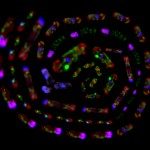Lien vers Pubmed [PMID] – 22384408
G3 (Bethesda) 2012 Feb;2(2):299-311
Polyploidization is an important process in the evolution of eukaryotic genomes, but ensuing molecular mechanisms remain to be clarified. Autopolyploidization or whole-genome duplication events frequently are resolved in resulting lineages by the loss of single genes from most duplicated pairs, causing transient gene dosage imbalance and accelerating speciation through meiotic infertility. Allopolyploidization or formation of interspecies hybrids raises the problem of genetic incompatibility (Bateson-Dobzhansky-Muller effect) and may be resolved by the accumulation of mutational changes in resulting lineages. In this article, we show that an osmotolerant yeast species, Pichia sorbitophila, recently isolated in a concentrated sorbitol solution in industry, illustrates this last situation. Its genome is a mosaic of homologous and homeologous chromosomes, or parts thereof, that corresponds to a recently formed hybrid in the process of evolution. The respective parental contributions to this genome were characterized using existing variations in GC content. The genomic changes that occurred during the short period since hybrid formation were identified (e.g., loss of heterozygosity, unilateral loss of rDNA, reciprocal exchange) and distinguished from those undergone by the two parental genomes after separation from their common ancestor (i.e., NUMT (NUclear sequences of MiTochondrial origin) insertions, gene acquisitions, gene location movements, reciprocal translocation). We found that the physiological characteristics of this new yeast species are determined by specific but unequal contributions of its two parents, one of which could be identified as very closely related to an extant Pichia farinosa strain.



